Goaltide Daily Current Affairs
Current Affair 1:
BCCI comes under ambit of NADA
We need to understand two important thing here:
- About NADA.
- What does this decision of BCCI to come under ambit of NADA means?
National Anti-Doping Agency (NADA)

National Anti-Doping Agency (NADA) was set up as registered society under the Societies Registration Act of 1890 on November 24, 2005 with a mandate for Dope free sports in India. It is responsible for promoting, coordinating, and monitoring the doping control program in sports in all its forms in the country. NADA works towards a vision of ’dope free’ sport in India.
NADA’S Primary function:
- Adopting and implementing anti-doping rules and policies which conform with the World Anti- Doping Code (code is explained below),
- cooperating with other sports related organizations and other anti-doping organizations,
- Encouraging reciprocal testing between National Anti-Doping Organizations, and
- Promoting anti-doping research & education
Code
The World Anti-Doping Code (Code) is the document that harmonizes regulations regarding anti-doping in sport across all sports and all countries of the world. The Code provides a framework for anti-doping policies, rules, and regulations for sport organizations and public authorities so that there may be a level playing field for all athletes worldwide.
Doping is defined by WADA as the occurrence of one or more of the following anti-doping rule violations mentioned in the WADA/NADA Code.
- Presence of a prohibited substance or its metabolites or markers in an athlete’s sample.
- Use or attempted use by an athlete of a prohibited substance or a prohibited method.
- Refusing to submit to sample collection after being notified.
- Failure to provide whereabouts information or being unavailable for doping control.
- Tampering with any part of the doping control process.
- Possession of a prohibited substance or method.
- Trafficking a prohibited substance or method.
- Administering or attempting to administer a prohibited substance or method to an athlete.
The World Anti-Doping Agency annually updates the List of Prohibited Substances and Methods.
Ignorance is never an excuse
Athletes should always check with their National Federations/ International Federations (IFs) to find out what additional substances and methods are prohibited in their sports. Also, athletes should always make their doctor aware that they are bound by the specific rules of their sport. Those who are unsure of what a product contains should not take it until they are sure it is not prohibited. Ignorance is never an excuse.
Jurisdiction of NADA
NADA is responsible to implement an effective number of in-competition and out-of-competition tests on the athletes in its registered testing pool. This includes international and national level athletes being tested by NADA. The NADA develops a test distribution plan and allocates the number of samples for each sport or discipline required for effective deterrence. The plan includes out-of-competition testing, in- competition testing, and may include blood as well as urine collection.
What does this decision of BCCI to come under ambit of NADA means?
Ending years of resistance, the Board of Control for Cricket in India (BCCI) finally came under the ambit of the National Anti-Doping Agency (NADA).
It means:
- National Anti-Doping Agency (NADA) can collect samples of all cricketers during domestic tournaments (Dileep Trophy, Ranji Trophy, etc. and all age group events)
- NADA cannot collect samples of its own accord during bilateral series (for e.g., the upcoming India-South Africa home series) unless instructed to do so by the International Cricket Council (ICC).
These matches are part of the ICC's Future Tours Programme (FTP) and the world body may continue with its arrangement with Sweden-based lab International Dope Tests and Management (IDTM) to collect samples.
However, if the ICC feels the need to get the cricketers tested by the NADA, it will inform the BCCI, which in turn will extend an invitation to NADA to come and test the cricketers.
- A third possibility too exists - the World Anti-Doping Agency (WADA) can direct ICC to authorize NADA to collect samples instead of IDTM.
Earlier, since the BCCI wasn't WADA Code compliant, the world body was finding it difficult to get the testing done through NADA.
- NADA also cannot collect samples of its own accord during ICC events in India (like the World T20 or World Cup). It is ICC's prerogative whether to get the testing done by its accredited agency IDTM or invite NADA.
- What happens to domestic dope testing in the IPL?
NADA can collect samples of all international and domestic cricketers in the IPL since it is a BCCI domestic event.
One more important thing for prelims exam is: There is a Governing Body of NADA. The Chairman of this Governing Body is Union Sports Minister.
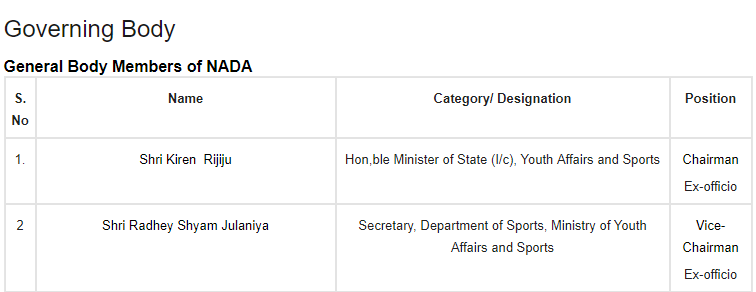
Current Affair 2:
Declaration Shillong

The Department of Administrative Reforms & Public Grievances, Ministry of Personnel, Public Grievances & Pensions and Ministry of Electronics & Information Technology in collaboration with the Government of Meghalaya organized the 22nd National Conference on e-Governance at Shillong during 8-9 August 2019.
The Conference has unanimously adopted the Shillong declaration outlined below after intensive deliberations during the sessions held over two days. The Conference resolved that Government of India and State Governments shall collaborate to:
- Improve the citizen’s experience with e-Government services
- Consolidation of all state level e- projects with a common application software with configurable features.
- Ensure improvement in ease of living and ease of doing business
- Take steps to further improve connectivity in North Eastern States
- Take steps to enhance the activities of Electronics Sector Skill Council in North Eastern States
- Promote use of e-Office and move towards less paper State Secretariats in the North-Eastern States and in the District level offices
- Improve the quality of delivery of e-Services in the North East to fulfil the vision of improved citizen experience.
- Develop India as a global cloud hub and facilitate development of Government applications and databases on Cloud by default
- Adopt emerging technologies for finding e-Governance solutions
- Promote the Digital India Projects with focus on Smart Cities and Smart
Villages through Startups and Smart Entrepreneurship.
Current Affair 3:
Trump Threatens to pull US out from the WTO
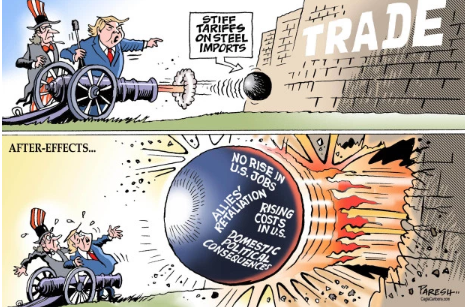
We don’t care if he is pulling out from the WTO or not. What is important for us is the reason behind this.
What US wants?
US wants restructuring of WTO and wants balance trade (because some countries designating themselves as developing countries are taking advantage- clearly pointing towards Indian and China).
Before proceeding, let us understand the structure of WTO.
Structure:
Basically, there are 3 types of countries in WTO,
- developed countries,
- developing countries and
- the least developed countries
There are no WTO definitions of “developed” and “developing” countries (very important for prelims).
So, the next question now is how we categorize which country to fall in which basket (developed, developing or least developed countries). Don’t worry we will explain you.
It’s very simple. The countries themselves categorizes in which basket they fall. For example, if country A says that I am developing country. WTO will say OK FINE, you are now a part of developing countries. But problem comes when any country challenges his decision (here country A decision to join developing country can be challenged). Now link this with present scenario.
Why US is angry?
US is challenging the decision of India and China, that they belong to developing nations category. According to US, India and China economies have already grown. They can’t be kept in category of developing countries anymore. Being a part of developing category basket, a country is eligible for certain concessions and benefits which is harming US economy.
What are the benefits available to Developing Countries?
In simple terms, The WTO Agreements contain special provisions which give developing countries special rights, and which give developed countries the possibility to treat developing countries more favorably than other WTO Members. These special provisions include, for example, longer time periods for implementing Agreements and commitments or measures to increase trading opportunities for developing countries, low tariffs, etc.
Let’s take example of India:
In financial year 2017-18, India's exports to the US were worth $47.9 billion. Imports from the US were worth $26.6 billion. This means trade balance being in India's favour by $21.3 billion. Since, India is under developing nation category, it has been provided some tariff benefits (tax on Indian goods in US is less, as a results Indian products become cheaper and they export more and more products to US. This is increasing trade deficit of US and Trump doesn’t like that)
What US wants now?
- It wants India to buy more goods from the US. A prominent example is of Harley-Davidson bikes. The US has demanded duty cuts on bikes imported to India. India reduced duty from 75% to 50% in February this year. But the US wants zero duty on these bikes. Another point of contention is capping of prices.
- A major sticking point between the US and India is capping of prices of several expensive medical devices, such as stents and knee implants, by the Indian government. While the Indian government's decision helps patients, especially poor ones, the US says its medical device industry suffers due to price caps. It wants the price caps to go.
- Another important issue is cow issue. US-origin dairy products are banned in India on religious and cultural grounds. The reason is that these dairy products are mostly derived from cows which consume feed containing internal organs, blood meal, or tissues of ruminant origin while the cow in India is considered sacred and a herbivore. The decision to prohibit US dairy products was taken in 2003 by the Vajpayee government. Trump is not happy with that.

Let us wait for further updates.
Current Affair 4:
India to seek boost to protection status of 5 species at CITES
First of all, we will see what CITIES is. We know you are thinking that you are aware of CITIES. But we are hundred percent sure, that you might not aware about all things we are going to discuss now, relevant for your Prelims 2020.
What is CITES?
CITES (the Convention on International Trade in Endangered Species of Wild Fauna and Flora) is an international agreement between governments. Its aim is to ensure that international trade in specimens of wild animals and plants does not threaten their survival.
Headquarter – Geneva, Switzerland.

How it works:
- CITES has no enforcement Authority (no police, authority, etc. to enforce rules). Each Party to the Convention must designate one or more Management Authorities in charge of administering that licensing system and one or more Scientific Authorities to advise them on the effects of trade on the status of the species.
- CITES is legally binding on state parties to the convention, which are obliged to adopt their own domestic legislation to implement its goals.
- CITES classifies species into three categories Appendix I, II and III and regulates their trade via cooperation of various nations.
Appendix 1- Totally banned
Appendix 2- Species that are not necessarily threatened but will get threatened if their trade is not controlled.
Appendix 3- list of species included at the request of any one nation but needs the cooperation of other countries to prevent unsustainable or illegal exploitation.
Conference of Parties (COP
The countries those have ratified the treaty are called Parties. These Parties meet at regular interval. Such meetings are called Conference of Parties (COP).

Very important section for Prelims.
- The Conference of the Parties (CoP) is held once every three years.
- The last Conference of the Parties (CoP 17) was held in Johannesburg, South Africa, in 2016 and the one before it (CoP 16) was held in Bangkok, Thailand, in 2013.
- The last (CoP 18) was in Sri Lanka in May 2019.
- India has hosted the Conference once. in 1981, i.e., CoP 3 in New Delhi (very important for prelims).
Now coming back to news:
India has submitted proposals regarding changes to the listing of various wildlife species in the CITES secretariat meeting, scheduled later this month in Geneva, Switzerland. The proposals submitted are regarding changes in the listing of the smooth-coated otter, small-clawed otter, Indian star tortoise, Tokay gecko, and Indian rosewood.
It will be good if at least you know the IUCN status of these five species:
- Smooth-coated otter- Vulnerable
- Small-clawed otter- Vulnerable
- Indian Start Tortoise-Vulnerable
- Tokay gecko- Least Concern
Indian Rosewood- Vulnerable.
Current Affair 5:
Banks cannot charge you on these ATM transactions: RBI Circular

When these circular are released, don’t just follow any coaching material directly. Try to read it by yourself. Circulars are released in English only. You can understand well. Often coaching materials miss things which are relevant for exam. So, we are attaching circular below and link both.

Points mentioned under it are:
- The RBI, in a circular dated 14 August, clarified that transactions which fail on account of technical reasons like hardware, software, and communication issues shall not be counted as valid ATM transactions for the customer.
- Other failed ATM transactions like non-availability of currency notes in the ATM, transaction declines attributable to the bank or service provider will also not be considered as valid ATM transactions for the customer.
- Invalid PIN/validations etc., which result in failed ATM transactions, will also be not counted as valid ATM transactions.
- Non-cash withdrawal transactions at ATMs such as balance enquiry, cheque book request, payment of taxes, funds transfer shall also not be part of the number of free ATM transactions.
Currently, India's largest bank State Bank of India offers eight free transactions to regular savings bank account holders, including five transactions at SBI ATMs and three at other bank ATMs. In non-metros,
such account holders get 10 free transactions, including five at SBI
ATMs and five at others.
Current Affair 6:
Textiles Ministry partners with 16 states for skilling 4 lakh under ‘Samarth’ scheme
What is important for us to know is about SAMARTH Scheme
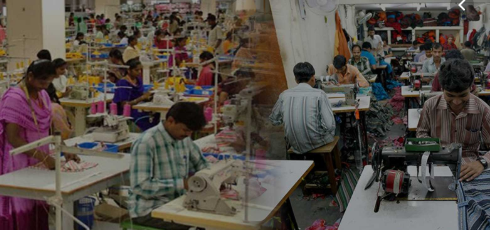
The Scheme for Capacity Building in Textile Sector (SCBTS) shall be known by the name Samarth signifying the broad objective of the scheme to skill the youth for gainful and sustainable employment in textile sector.
We will learn here,
- Ministry
- Objective of Scheme
- Institutional Mechanisms
Ministry: This scheme comes under Ministry of Textiles.
Objective:
- to provide demand-driven, placement-oriented skilling programme to incentivize the efforts of the industry in creating jobs in the organized textile and related sectors
- to promote skilling and skill up-gradation in the traditional sectors through respective sectoral divisions/organizations of Ministry of Textile; and
- to provide livelihood to all sections of the society across the country.
- The Scheme would target to train 10 lakh persons over a period of 3 years (2017-20).
Institutional Mechanisms (very important for prelims):
Three important committees will be set up:
- Inter-Ministerial Committee: It will be set up under chairmanship of Union Minister of textiles to monitor the progress of the scheme on half-yearly basis.
- Empowered Committee: An inter-ministerial Empowered Committee chaired by Secretary, Ministry of Textiles for effective monitoring and implementation of scheme and approval of detailed Project Reports and Standard Operating Procedures.
- Proposal Evaluation Committee under chairmanship of Joint Secretary for approval of proposals submitted by Implementation Agencies.
Current Affair 7:
All India Tiger Estimation Report 2018 released recently
Before proceeding, let us understand why saving Tigers is important?
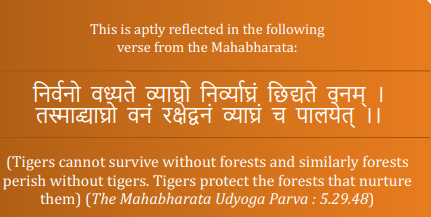
The tiger is a unique animal which plays a pivotal role in the health and diversity of an ecosystem. It is a top predator which is at the apex of the food chain and keeps the population of wild ungulates in check, thereby maintaining the balance between prey herbivores and the vegetation upon which they feed. Therefore, the presence of tigers in the forest is an indicator of the wellbeing of the ecosystem.
The extinction of this top predator is an indication that its ecosystem is not sufficiently protected, and neither would it exist for long thereafter.
Now coming back to report. We will not focus on what methods they used for estimation of Tigers. We will directly focus on results of the report.
Prime Minister Narendra Modi released 4th cycle of the All India Tiger Estimation Report 2018.
The report was prepared by the National Tiger Conservation Authority (NTCA), a statutory body under the Ministry of Environment, in collaboration with the Wildlife Institute of India (WII).
Findings of the Report: The next few diagrams given below is enough to understand the Status of tiger given in the report.
Tiger occupancy (occupancy is not number, so don’t get confused by seeing diagrams) has increased in the state of Madhya Pradesh and Andhra Pradesh. Loss in North East is due to poor sampling. Madhya Pradesh has also registered a substantial increase in their tiger population and along with Karnataka ranks highest in tiger numbers. The poor and continuing decline in tiger status in the states of Chhattisgarh and Odisha is a matter of concern. Now go to charts given below:


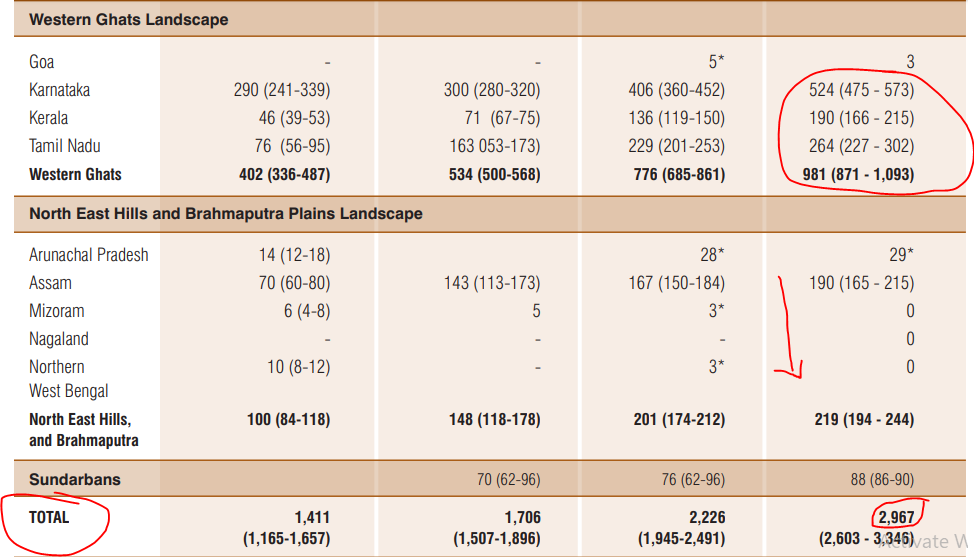
|
|


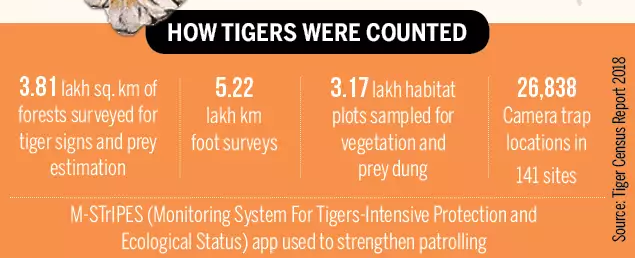
Students, Tiger reserves will be very important for the coming Prelims Examination. We have already mentioned this in our Daily Quiz section.
Current Affair 8:
What is Inverted Yield Curve?
One factor particularly spooking the markets in recent days has been the “inversion of the yield curve” in the United States.
Let us understand about this curve.
The yield curve is a graph showing the relationship between interest rates earned on lending money for different durations.
What is normally observed?
Normally, someone who lent to the government or a corporation for one year (by buying a one-year government or corporate bond) would expect to get a lower interest rate than someone who lent for five or ten years, making the yield curve upward-sloping.
But what has been observed these days?
Yields on 10-year US Treasury bonds dipped below the yield on the US 2-year bond. It was the first time the 10-year yield was below the 2-year yield since 2007 — just before the Great Recession.
In simple terms, long terms loans are yielding low interest rates than short term loans (just opposite of normal behaviour).
This is significant. When shorter-term rates are higher than longer-term bond yields, that is known as an inverted yield curve.

Why this is worrying?
It is worrying because before each recession in US same trend was observed (inverted yield slope). Therefore, there can be a possibility a recession may occurs again in US as inverted Yield Curve is back again.
Current Affair 9:
FDA approves new oral three-drug regimen for extensively drug-resistant TB

The US Food and Drug Administration (FDA) has approved new oral three-drug regimen for the extensively-drug resistant tuberculosis (XDR-TB), estimated to have a mortality rate of 60 per cent.
Tuberculosis is a bacterial infection that caused about 1.6 million deaths globally in 2017. When TB infection becomes resistant to the first line of treatment — isoniazid and rifampicin, it is called MDR-TB. However, when the infection becomes resistant even to the second-line treatment, it is called XDR-TB.
There are 1,14,237 MDR-TB patients globally, of which more than 8,000 are XDR-TB, according to 2018 WHO TB update. India has 26,966 MDR-TB patients, the highest in the world, while there are 2,130 XDR-TB patients in the country.
The treatment involves pretomanid tablets in combination with Bedaquiline and linezolid, collectively referred to as the BPaL regimen. It has an efficacy rate of 90 per cent.
Previously available drugs had a success rate of only 34 per cent for XDR-TB and 55 per cent for multi-drug resistant TB (MDR-TB) cases, according to the World Health Organization (WHO). They also had severe side-effects like deafness, numbness, joint pain, renal failure hormonal imbalance, vertigo, among others.
Current Affair 10:
Jal Jeevan Mission
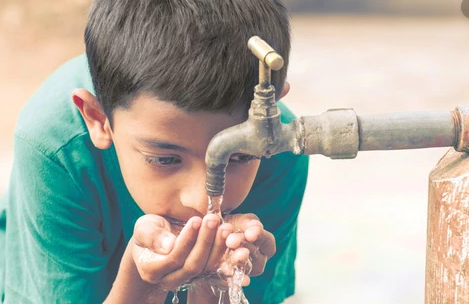
This scheme comes under the aegis of Jal Shakti Ministry.
About new Ministry:
The new ministry has been formed by merging the Ministry of Water Resources, River Development and Ganga Rejuvenation and Ministry of Drinking Water and Sanitation.
Mission: The scheme ensures Har Ghar Jal (piped water supply) to all rural households by 2024.
Now, let’s see what Constitution talks about Water.
- Water is a State List Subject (Entry 17).
- Inter-state Rive Water dispute is a Union List subject (Entry 56)
Therefore, Irrigation, water storage, Water Management, Water Harvesting, Water supply, etc. comes under state government.
Now about the Mission:
- It aims at integrated Water Management- focus on Groundwater, Rain water and focus on Waste water
- It is a decentralized mission, i.e., Central government will have less powers, promoting decentralization.
- Promoting sustainable Water usage.
Now the most important points for exam:
Three focuses: All three focuses together can be called as Integrated water management.
- Groundwater
Wherever sufficient quantity and good quality of groundwater exists, these schemes would be managed by the community itself through the setting up of a village water and sanitation committee, a sub-committee of the gram panchayat on drinking water and sanitation.
- Surface water
If quality and quantity is poor, the government will not focus on ground water, instead in those areas surface water-based multi-village schemes will be promoted.
- Waste Water
Mission for the effective channeling and treatment of household waste water (known as grey water), through appropriate and low-cost drainage and treatment systems.
This is more than sufficient for the Exam.
Current Affair 11:
Confederation of Indian Industry,
. According to survey by Confederation of Indian Industry, Indian Firms operating in China will increase investment in China.
Two things you are going to learn from this:
- What all are the reasons, Indian firms are investing in China?
- About Confederation of Indian Industry (CII)
Reasons are mentioned in image below itself
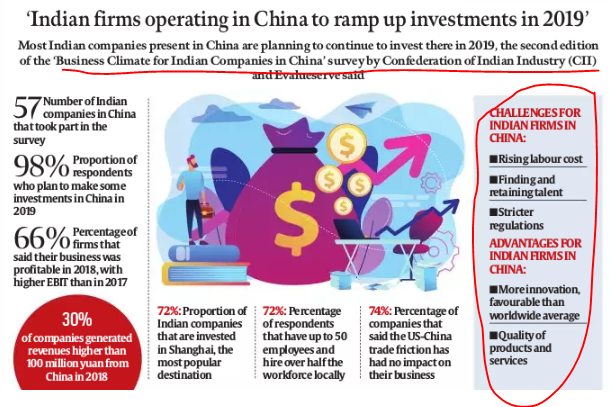
Confederation of Indian Industry
CII is a non-government, not-for-profit, industry-led and industry-managed organization, playing a proactive role in India's development process.
Its primary goal is to develop Indian industry and to ensure that government and society as a whole, understand both the needs of industry and its contribution to the nation's wellbeing.
CII membership is open to any Company or Firm in India engaged in manufacturing activity or providing consultancy services.
There is no Individual membership in CII. Companies from the same group are to take up membership separately, since there is no group membership.
CII works in collaborations with various ministries and organize various conferences to strengthen industry's role in the economic development of the country. For example,
- The 14th CII-EXIM Bank Conclave on India-Africa Project Partnerships was held in March 2019.
- The joint annual flagship, Department of Science and Technology and CII, ‘Technology Summit’ discussed research & development collaboration opportunities between India and Italy in the areas of aerospace, clean-tech, cultural heritage, education, healthcare, ICT and renewable energy.
Current Affair 12:
Plant Mutation Breeding Network launched jointly by IAEA and FAO

Background:
With populations growing rapidly, particularly in Asia and the Pacific, farmers and scientists are all the more drawing on the benefits of using irradiation to develop new crop varieties and meet farmers’ needs: higher, stable yields and high-quality plants that can resist disease and climate change. Don’t know about other countries. But India needs it all.
The Plant Mutation Breeding Network, or MBN, aims to improve efficiencies in crop mutation breeding across the region. This goes from accelerating the discovery of better traits in plants, to advancing speed-breeding technologies to get improved traits and facilitating farmers’ access to the improved seeds. “The ultimate goal is to ensure food and nutrition security and improve livelihoods through regional cooperation and knowledge and technology exchange”.
It was launched jointly by International Atomic Energy Agency and Food Agricultural Organization.
About international Atomic Energy Agency

The International Atomic Energy Agency is the world's central intergovernmental forum for scientific and technical co-operation in the nuclear field. It works for the safe, secure and peaceful uses of nuclear science and technology, contributing to international peace and security and the United Nations' Sustainable Development Goals.
Headquarter – Vienna, Austria
Members:
India has been a member of the International Atomic Energy Agency (IAEA), a UN organization set up to promote peaceful uses of atomic energy, since its inception in 1957. Don’t get confuse with International Energy Agency (IEA). For IEA, India is an associate member.
Latest members to join IAEA. This is also important for Prelims.

Current Affair 13:
Scientists of the Zoological Survey of India have discovered new species of freshwater fish

While Glyptothorax gopii, a new species of catfish was found in Mizoram’s Kaladan river, Garra simbalbaraensis was found in Himachal Pradesh’s Simbalbara river. Both fish, measuring less than seven centimeters, are hill stream fauna and are equipped with special morphological features to suit rapid water flow.
Don’t need to know shape, size and colour of fish.
About Zoological Survey of India
The Zoological Survey of India (ZSI), founded on 1 July 1916 by Government of India Ministry of Environment, Forest and Climate Change, as premier Indian organisation in zoological research and studies to promote the survey, exploration and research of the fauna in the country.
It is headed neither by Union Minister nor Secretary.
Current Affair 14:
Vice President M. Venkaiah Naidu has embarked on a three-nation visit to Lithuania, Latvia and Estonia
Important for us is the location of these places with capitals.
Few important things you observed from map below:
- Russia shares boundary with all three Baltic states (with Lithuania also).
- Arrange all the Gulfs in map from North to South
- Countries sharing boundaries with these states.
- Capitals of all these three states
- Baltic Sea.
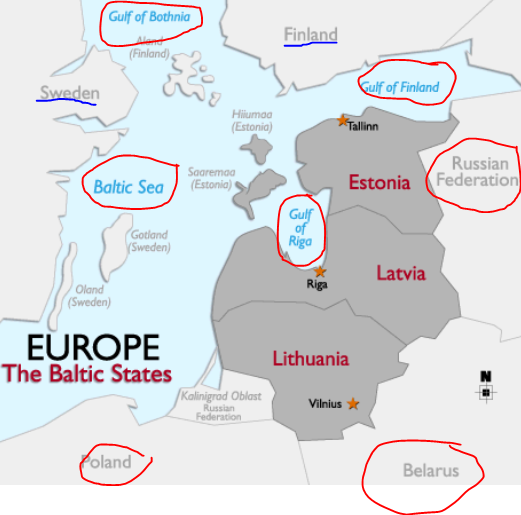
Current Affair 15:
GI Tag accorded to three new products
The Geographical Indication (GI) under the Department for Promotion of Industry and Internal Trade has recently registered 4 new GIs.
- Palani Panchamirtham from Palani Town in Dindigul District of Tamil Nadu State (A temple 'prasadam’)
- Tawlhlohpuan (a medium to heavy, compactly woven, good quality fabric) and Mizo Puanchei (colourful Mizo shawl) from the state of Mizoram
- Tirur Betel leaf from Kerala
Geographical Indications:
The Trade-Related Aspects of Intellectual Property Rights (TRIPS) prescribes minimum standards of protection of GIs and additional protection for wines and spirits.
Articles 22 to 24 of the TRIPS prescribe minimum standards of protection to the geographical indications that WTO members must provide. India, in compliance with its obligation under TRIPS, has taken legislative measures by enacting the Geographical Indications of Goods (Registration and Protection) Act, 1999, which came into effect on 15th September 2003 and the Geographical Indications of Goods (Registration and Protection) Rules, 2002.
As per the (Indian) Geographical Indications of Goods (Registration and Protection) Act, 1999 "Geographical Indication", in relation to goods, means an indication which identifies such goods as agricultural goods, natural goods or manufactured goods as originating, or manufactured in the territory of a country, or a region or locality in that territory, where a given quality, reputation or other characteristic of such goods is essentially attributable to its geographical origin.
Who is responsible for IPR in India?
Department for Promotion of Industry and Internal Trade, Ministry of Commerce and Industry is responsible for Intellectual Property Rights relating to Patents, Designs, Trade Marks and Geographical Indication of Goods and oversees the initiative relating to their promotion and protection.
Whom to file for GI Tag registration?
An application for the registration of a GI is to be made to the Registrar of Geographical Indications in the form prescribed under the Geographical Indications of Goods (Registration and Protection) Act, 1999 (the GI Act) read with the Geographical Indications (Registration and Protection) Rules, 2002 (the GI Rules).
Duration of Protection
A Geographical Indication is registered for a period of 10 years and the registration may be renewed from time to time for a period of 10 years at a time
Current Affair 16:
Ministry of Corporate Affairs amends provisions related to Differential Voting Rights under Companies Act
First and most important thing is to understand what Differential Voting Rights is.
Differential Voting Rights (DVRs) enable promoters to retain control over the company even after many new investors come in.
For example, suppose A is starting a business. A needs money to start a business. Under normal shares, if A raises fund from someone, A has to dilute its stakes in the company. Under Differential Voting Rights, A don’t need to dilute its stake, just A has to pay extra premium to those who have invested in A’s start- up company.
Therefore, A will not need to dilute its stake in company, just has to pay extra dividend.
What changes has been bought?
Before reading the changes understand what is paid up capital and Post- issue paid up capital.
Paid-Up Capital
Paid-Up Capital is the amount of money a company has been paid from shareholders in exchange for shares of its stock. Paid-up capital is important because it's capital that is not borrowed. A company that is fully paid-up has sold all available shares and thus cannot increase its capital unless it borrows money by taking on debt.
Post- Issue paid up Capital
For example, if the paid-up share capital of a company is INR 100,000, and Mr. A invests an amount of INR 30,000 for 3000 shares of INR 10 each, then the post issue paid up share capital after Mr. A’s investment shall be INR 1,30,000.
Now see changes brought
- removal of the earlier requirement of distributable profits for 3 years for a company to be eligible to issue shares with Differential Voting Rights.
- Time period within which Employee Stock Options (ESOPs) can be issued by Startups to promoters or Directors holding more than 10% of equity shares, has been enhanced from 5 years to 10 years from the date of their incorporation.
- Enhancement in the previously existing cap of 26% of the total post issue paid up equity share capital to a revised cap of 74% of total voting power in respect of shares with Differential Voting Rights of a company.
Current Affair 17:
Election Commission kicks off delimitation process in J&K
The Jammu and Kashmir Reorganization Act, 2019 provides for,
- It provides for delimitation of Parliamentary constituencies of the two Union Territories of Jammu and Kashmir and Ladakh.
- As per the Re-organisation Act, the number of seats in the Legislative Assembly of the UT of J&K would be increased from 107 to 114
- The Act also specifies that delimitation will be based on the 2011 census till 2026.
What is mention in Constitution about Delimitation?
Article 82 of Indian Constitution provides for delimitation and it says: Upon the completion of each census, the allocation of seats in the House of the people to the States and the division of each State into territorial constituencies shall be readjusted by such authority and in such manner as Parliament may by law determine.
Delimitation Commission:
As per Article 82, Parliament by law enacted a Delimitation Act after every census. Once the Act comes into force, the Central Government constitutes a Delimitation Commission.
Therefore, Delimitation Commission have been constituted four times since independence:
- In 1952 under Delimitation Commission Act, 1952
- In 1963 under Delimitation Commission Act, 1962
- In 1973 under Delimitation Commission Act, 1972
- In 2002 under Delimitation Commission Act, 2002
Orders of Delimitation Commission cannot be called in question before any Court of law.
The copies of its orders are laid before the House of People and the State Legislative Assembly concerned, but no modifications are permissible therein by them.
Now the most important thing for Prelims is Delimitation Commission.

Justice Kuldeep Singh was the Chairperson of Delimitation Commission, 2002.
Current Affair 18:
RBI finalizes regulatory sandbox framework for innovation in fintech firms

The RBI has recently issued the final framework for the regulatory sandbox in order to enable innovations in the financial technology space.
In this regard, let us discuss various aspects of Fintech companies and need for Sandbox Policy for their development.
What are Fintech Companies?
The term “FinTech” is a combination of the word’s “finance” and “technology”. It refers to the technological start-ups that are emerging to challenge traditional banking and financial players.
What is Sandbox Policy?
The Sandbox policy is designed to encourage innovation by the Fintech companies within a well-defined space and duration where regulators would provide the requisite regulatory support. The Sandbox policy allows companies to test products in a closed environment i.e. within a particular or among a set of users, before they are allowed roll out commercially.
Benefits of Sandbox Policy
Users of a sandbox can test the product’s viability without the need for a larger and more expensive roll out. If the product appears to have the potential to be successful, the product might then be authorized and brought to the broader market more quickly.
However, if concerns are unearthed while the product is in the sandbox, appropriate modifications can be made before the product is launched more broadly.
Current Affair 19:
DRDO is presently working on the next generation military technologies known as Directed energy Weapons (DEWs).
About Directed Energy Weapons

A DEW emits energy in an aimed direction without the means of a projectile. It transfers energy to a target and introduces uneven heat stresses, leading to failure of structural integration of the target and causing its destruction.
Laser-based or microwave-based high-power DEWs can easily incapacitate almost all ariel targets like drones, missiles and other targets without leaving any physical debris.
What are the advantages of Direct Energy Weapons?
- Travels at the speed of light and no complicated calculation for target movement necessary.
- Not affected by gravity (no trajectory calculations required).
- Can be invisible and silent; attacker remains concealed.
- Lower Duration for deployment (reduces exposure of launcher to enemy position)
- Operation range larger than conventional weapons
- Recharging of magazine non-existent, only source of energy required
Challenges with Direct Energy Weapons
- The target has to be in the line of sight of the laser.
- Due to divergence of a beam of light, the range gets restricted to a few 100 km and not beyond.
- Presently, the requirement of energy source is large, but with advancement in superconductivity and nanotechnology, this problem is being worked upon.
- Laser light can be deflected, reflected, or absorbed by manipulating physical and chemical properties of materials.
Current Affair 20:
FSSAI implements ban on colistin use

The Food Safety and Standards Authority of India (FSSAI) on August 8, 2019 issued a draft regulation to prevent the use of antibiotic colistin in food, banned by the Union government in July.
According to the Food Safety and Standards (Contaminants, Toxins and Residues) Amendment Regulations 2019, colistin will be added to the list of antibiotics and veterinary drugs that are prohibited for use in processing of meat and meat products, poultry and eggs, sea foods including shrimps, prawns or fish and fishery products.
What is WHO status on Colistin?
As per WHO, Colistin has been marked ‘Reserved’, meaning it should only be used as a last resort when all other antibiotics have failed.
Apparently, colistin is also listed as a highest priority critically important antibiotic (HPCIA) in the WHO’s list of critically important antimicrobials for human medicine. But it is allowed to be used for non-therapeutic purposes in animals. This includes its use for growth promotion (for example fattening of broiler poultry in less time and with less feed) as well as for preventing diseases in healthy animals.
Being an HPCIA implies that colistin is the sole or one of limited available therapies to treat serious bacterial infections in people.
Why it is banned
Colistin, which is a last resort antibiotic for humans, is used to treat drug-resistant gram-negative infections in critically ill patients.
When colistin fails, doctors are left with the limited option of using fosfomycin that costs nearly Rs 24,000 per day. This is very expensive and hence would be unaffordable to many patients.
<< Previous Next >>


